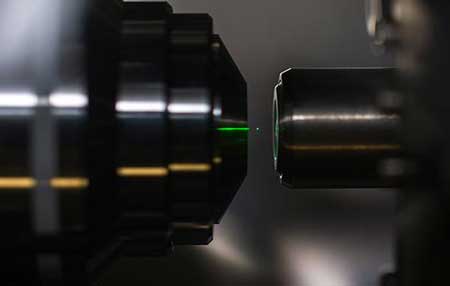Rochester Institute of Technology researcher leading a three-year study on precision quantum sensing funded by a $550,000 grant from the U.S. Department of the Navy’s Office of Naval Research, officials announced Wednesday.
Research underway at RIT advances a new kind of sensing technology that captures data with better precision than currently possible and promises cheaper, smaller and lighter sensor designs.Mishkat Bhattacharya, a theoretical physicist at RIT, is investigating new precision quantum sensing solutions for the U.S. Department of the Navy’s Office of Naval Research.
The three-year study is supported by $550,000 grant and is a continuation of a previous award. Bhattacharya will test interactions between light and matter at the nanoscale and analyze measurements of weak electromagnetic fields and gravitational forces.Specialized microscopes measure theoretical predictions that describe matter at the nanoscale in which a nanometer equals one-billionth of a meter and a human hair measures between 80,000-100,000 nanometers, according to the U.S. National Nanotechnology Initiative.

It’s no trick of the eye; it’s an optical trap.
Levitated optomechanics can make a nanoparticle float in space. A finely focused laser beam forms an “optical tweezer” and creates a tiny, isolated laboratory for the study of delicate quantum states. RIT scientist Mishkat Bhattacharya tests his theoretical predictions on such experimental platforms used by his collaborator Nick Vamivakas at the University of Rochester’s Institute of Optics. (Image: J. Adam Fenster and Prof. A. N. Vamivakas, University of Rochester)Bhattacharya works in the emerging field of levitated optomechanics, an area of physics that investigates nanoparticles by trapping them in a laser beam.
Laser trapping–a method known as “optical tweezers”–tests the limits of quantum effects in isolation and eliminates physical disturbances from the surrounding environmentUsing the techniques of laser trapping, Bhattacharya takes quantum mechanics to the next level by probing quantum effects in the nanoparticles, which contain billions of atoms. He investigates where quantum mechanics (which governs the microscopic) butts up against classical physics (which explains the macroscopic) and explores light-matter interaction in macroscopic quantum physics.
“Levitated optomechanical systems provide a clean platform for studying quantum optics, information science, and precision measurement and sensing,” said Bhattacharya, an associate professor in RIT’s School of Physics and Astronomy and a member of the Future Photon Initiative.To explore different nanosystems for the Office of Naval Research, Bhattacharya isolates a nanodiamond in a pocket of light. Suspension in laser light turns the particle into a floating probe. Bhattacharya is interested in the signatures carried in the light and the information it reveals about the electromagnetic fields and the gravitational forces surrounding the nanoparticle.He collaborates with postdoctoral associate Pardeep Kumar and RIT undergraduate physics major Wyatt Wetzel. This summer, a visiting undergraduate from Massachusetts Institute of Technology, Peter Mizes, joined his Atomic, Molecular and Optical Physics Theory Group. Bhattacharya tests his theoretical predictions in a lab run by his collaborator Nick Vamivakas, an experimental physicist at the University of Rochester’s Institute of Optics.His first study for the Office of Naval Research determined the smallest force that could be detected with a diamond crystal that levitated without spinning. The new project investigates the outcomes of three nanosystems, each using nanoparticles optically trapped under different conditions:
- A particle containing an impurity which acts as a spin sensitive to magnetic fields or as an excess charge sensitive to electric fields;
- A particle moving like a pendulum in three dimensions;
- A particle larger than the wavelength of light entrapping it.
Quantum mechanics is a door to a world on the nanoscale and is governed by a different set of physical laws.”Unique rules apply in quantum physics,” Bhattacharya said. “It is not the day-to-day physical universe familiar to our experience.”Optomechanics explores interactions between light and tiny particles of matter within the nano-realm. Sensing technology advanced at these submicroscopic scale promises finer measurements of physical properties that describe the world, such as electric and magnetic fields, temperature, force, velocity, acceleration, gravitation.According to Bhattacharya, quantum sensors might someday detect gravitational waves, find dark matter, perfect quantum computing and create precise accelerometers–the technology that rights display screens held at any angle.
Read more: Sensing technology takes a quantum leap with photonics research A
“”Quantum sensing” describes the use of a quantum system, quantum properties or quantum phenomena to perform a measurement of a physical quantity. Historical examples of quantum sensors include magnetometers based on superconducting quantum interference devices and atomic vapors, or atomic clocks. More recently, quantum sensing has become a distinct and rapidly growing branch of research within the area of quantum science and technology, with the most common platforms being spin qubits, trapped ions and flux qubits. The field is expected to provide new opportunities – especially with regard to high sensitivity and precision – in applied physics and other areas of science”
